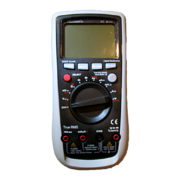Voltcraft VC-870
Revision as of 12:17, 17 December 2024 by Tsaitgaist (talk | contribs) (replace dead links with wbm)
 | |
| Status | supported |
|---|---|
| Source code | serial-dmm |
| Counts | 40000 |
| IEC 61010-1 | CAT III (1000V) / CAT IV (600V) |
| Connectivity | RS232 / USB |
| Measurements | voltage, resistance, diode, continuity, capacitance, frequency, current, temperature, loop current, power + apparent power, power factor + frequency, effective voltage + current |
| Features | autorange, hold, relative, backlight, min, max, minmax, true-rms, bargraph |
| Website | conrad.de |
The Voltcraft VC-870 is a 40000 counts, CAT III (1000V) / CAT IV (600V) handheld digital multimeter with RS232 or USB connectivity.
Hardware
Multimeter:
We don't have teardown photos yet, but this article (see also this photo) claims that the DMM contains the following components:
- 4 3/4 and 5 3/4 digits ADC: Cyrustek ES51966 (datasheet)
- Microcontroller: Texas Instruments MSP430
- Voltage regulators: TPS76301, 7201u55
- EEPROM: Atmel "748"
- True RMS-to-DC converter: Analog Devices AD737 (datasheet)
RS232 cable:
USB cable:
Photos
Multimeter:
RS232 cable:
See Device cables#UNI-T_UT-D02.
USB cable:
See Device cables#UNI-T_UT-D04.
Protocol
Some (partially incorrect and also incomplete) protocol docs are available from the vendor.
The interface parameters for the UNI-T UT-D02 serial cable are 9600/8n1.
A packet consists of 23 bytes:
| Byte(s) | Name | Description |
|---|---|---|
| 0 | Function code | Bytes 0 and 1 determine the measurement mode. |
| 1 | Function select code | Bytes 0 and 1 determine the measurement mode. |
| 2 | Range | |
| 3-7 | 5 main display digits | |
| 8-12 | 5 auxiliary display digits | |
| 13 | ? | |
| 14 | ? | |
| 15 | Status | |
| 16 | Option 1 | |
| 17 | Option 2 | |
| 18 | Option 3 | |
| 19 | Option 4 | |
| 20 | Dual display | |
| 21 | Line feed | Always 10 / 0x0a. |
| 22 | Carriage return | Always 13 / 0x0d. |
Measurement modes:
| Function code | Function select code | Measurement mode |
|---|---|---|
| 0x30 | 0x30 | DCV |
| 0x30 | 0x31 | ACV |
| 0x31 | 0x30 | DCmV |
| 0x31 | 0x31 | Temperature (Celsius and Fahrenheit) |
| 0x32 | 0x30 | Resistance |
| 0x32 | 0x31 | Continuity |
| 0x33 | 0x30 | Capacitance |
| 0x34 | 0x30 | Diode |
| 0x35 | 0x30 | Frequency |
| 0x35 | 0x31 | Loop current, (4-20mA)% |
| 0x36 | 0x30 | DCuA |
| 0x36 | 0x31 | ACuA |
| 0x37 | 0x30 | DCmA |
| 0x37 | 0x31 | ACmA |
| 0x38 | 0x30 | DCA |
| 0x38 | 0x31 | ACA |
| 0x39 | 0x30 | Active/real power + apparent power |
| 0x39 | 0x31 | Power factor + frequency |
| 0x39 | 0x32 | Voltage effective value + current effective value |
Notes:
- The bargraph value (only shown on the LCD for voltage, current, and resistance mode) is not contained in the protocol.
- The auto-poweroff feature which powers the device off after 15 minutes is always disabled when the PC interface is "active" (i.e. the user pressed the REL/PC button for 1 second). Thus the respective "auto-poweroff" bit/flag, which is contained in the protocol, always has the same value.
- The backlight status (on/off) is contained in the protocol.